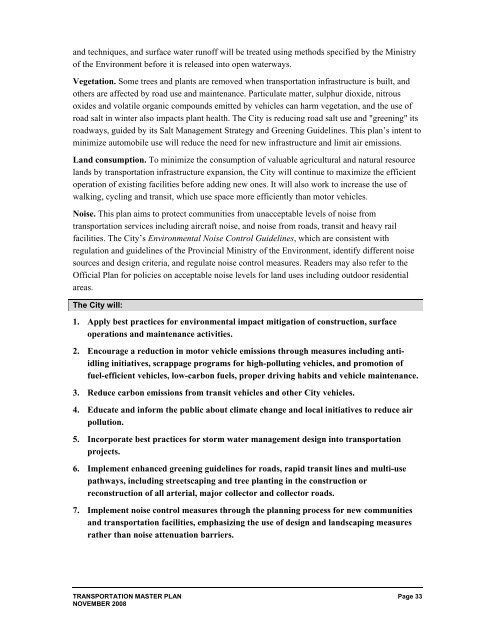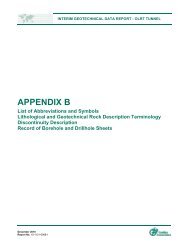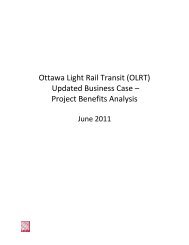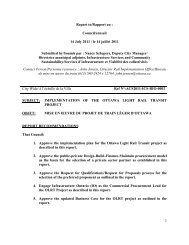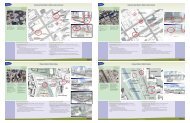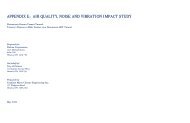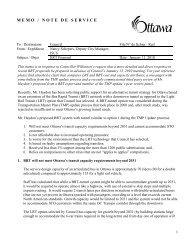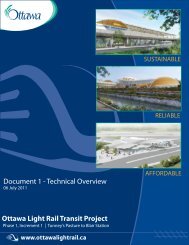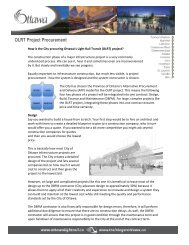Transportation Master Plan - Ottawa Confederation Line
Transportation Master Plan - Ottawa Confederation Line
Transportation Master Plan - Ottawa Confederation Line
You also want an ePaper? Increase the reach of your titles
YUMPU automatically turns print PDFs into web optimized ePapers that Google loves.
and techniques, and surface water runoff will be treated using methods specified by the Ministry<br />
of the Environment before it is released into open waterways.<br />
Vegetation. Some trees and plants are removed when transportation infrastructure is built, and<br />
others are affected by road use and maintenance. Particulate matter, sulphur dioxide, nitrous<br />
oxides and volatile organic compounds emitted by vehicles can harm vegetation, and the use of<br />
road salt in winter also impacts plant health. The City is reducing road salt use and "greening" its<br />
roadways, guided by its Salt Management Strategy and Greening Guidelines. This plan’s intent to<br />
minimize automobile use will reduce the need for new infrastructure and limit air emissions.<br />
Land consumption. To minimize the consumption of valuable agricultural and natural resource<br />
lands by transportation infrastructure expansion, the City will continue to maximize the efficient<br />
operation of existing facilities before adding new ones. It will also work to increase the use of<br />
walking, cycling and transit, which use space more efficiently than motor vehicles.<br />
Noise. This plan aims to protect communities from unacceptable levels of noise from<br />
transportation services including aircraft noise, and noise from roads, transit and heavy rail<br />
facilities. The City’s Environmental Noise Control Guidelines, which are consistent with<br />
regulation and guidelines of the Provincial Ministry of the Environment, identify different noise<br />
sources and design criteria, and regulate noise control measures. Readers may also refer to the<br />
Official <strong>Plan</strong> for policies on acceptable noise levels for land uses including outdoor residential<br />
areas.<br />
The City will:<br />
1. Apply best practices for environmental impact mitigation of construction, surface<br />
operations and maintenance activities.<br />
2. Encourage a reduction in motor vehicle emissions through measures including antiidling<br />
initiatives, scrappage programs for high-polluting vehicles, and promotion of<br />
fuel-efficient vehicles, low-carbon fuels, proper driving habits and vehicle maintenance.<br />
3. Reduce carbon emissions from transit vehicles and other City vehicles.<br />
4. Educate and inform the public about climate change and local initiatives to reduce air<br />
pollution.<br />
5. Incorporate best practices for storm water management design into transportation<br />
projects.<br />
6. Implement enhanced greening guidelines for roads, rapid transit lines and multi-use<br />
pathways, including streetscaping and tree planting in the construction or<br />
reconstruction of all arterial, major collector and collector roads.<br />
7. Implement noise control measures through the planning process for new communities<br />
and transportation facilities, emphasizing the use of design and landscaping measures<br />
rather than noise attenuation barriers.<br />
TRANSPORTATION MASTER PLAN Page 33<br />
NOVEMBER 2008


